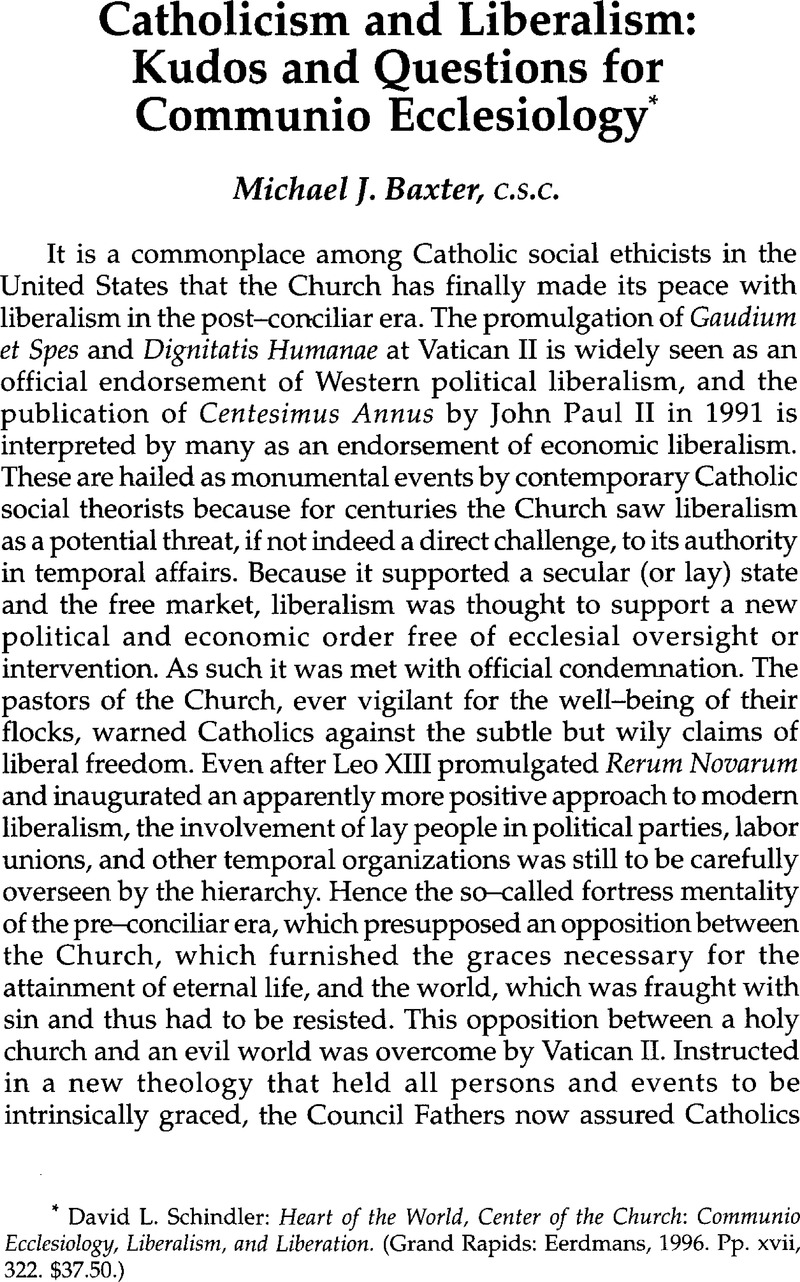No CrossRef data available.
Article contents
Catholicism and Liberalism: Kudos and Questions for Communio Ecclesiology*
Published online by Cambridge University Press: 05 August 2009
Abstract

- Type
- Review Essay
- Information
- Copyright
- Copyright © University of Notre Dame 1998
References
1. Komonchak, Joseph, “Vatican II and the encounter between Catholicism and liberalism,” in Catholicism and Liberalism, ed. Douglas, R. Bruce, and Hollenbach, David (Cambridge: Cambridge University Press, 1994), pp. 76–99.CrossRefGoogle Scholar
2. The article on which Schindler relies is Bradley, Gerard V., “Beyond Murray's Articles of Peace and Faith,” in John Courtney Murray and the American Civil Conversation, ed. Hunt, Robert P., and Grasso, Kenneth L. (Grand Rapids: Eerdmans, 1992), pp. 181–204.Google Scholar
3. The passage is from Lindbeck, George “John Courtney Murray, S.J.: An Evaluation,” Christianity and Crisis 21 (11 27, 1961): 213–16.Google Scholar
4. Komonchak, Joseph, “John Courtney Murray and the Redemption of History: Natural Law and Theology,” in John Courtney Murray & the Growth of Tradition, ed. Hooper, J. Leon, S.J. and Whitmore, Todd David (Kansas City, KS: Sheed and Ward, 1996), pp. 60–81, see especially pp. 67–68.Google Scholar
5. Ibid., p. 61.
6. Ibid., p. 79.
7. Murray, John Courtney, We Hold These Truths (New York: Sheed and Ward, 1960), p. 109.Google Scholar
8. The work cited is Hooper, J. Leon, S.J., introduction to John Courtney Murray, S.J., Religious Liberty: Catholic Struggles with Pluralism, ed. Hooper, J. Leon, (Louisville, KY: Westminster/John Knox, 1993), pp. 11–48.Google Scholar
9. See for example, Hollenbach, David, “Public Theology in America,” Theological Studies 37 (1976): 290–303;CrossRefGoogle ScholarColeman, John, “A Possible Role for Biblical Religion in Public Life,” in “Theology and Philosophy in Public: A Symposium on John Courtney Murray's Unfinished Agenda,” Theological Studies 40 (1979): 705;Google ScholarHimes, Michael J. and Himes, Kenneth R., O.F.M., Fullness of Faith: The Public Significance of Theology (New York: Paulist, 1993), especially pp. 8–20.Google Scholar
10. As regards the label “liberationist,” it is misleading when attached to public theologians in the United States. Their positive assessment of the workings of liberal democracy in the United States puts them in stark contrast to most Latin American liberation theologians whose general perspective on U.S. politics is not as positive, and rightly so.
11. This is the basic argument presented in my review of Fullness of Faith by Michael and Kenneth Himes. Baxter, Michael J., C.S.C., “Review Essay: The Non–Catholic Character of the ‘Public Church,’” Modern Theology 11 (04 1995): 243–5.CrossRefGoogle Scholar
12. Whether or not one can legitimately attribute this understanding of freedom to de Lubac, at least in the context of these political questions, is a matter that is open to debate, but which will not be addressed here. For de Lubac's views on church and state, see de Lubac, Henri, Theological Fragments (San Francisco: Ignatius Press, 1989), pp. 199–286.Google Scholar
13. This is a point made in reference to the “public theologians” in Komonchak, , “Murray and the Redemption of History,” pp. 80–81.Google Scholar
14. MacIntrye, Alasdair, After Virtue (Notre Dame: Notre Dame Press, 1984),Google Scholar and “A Partial Response to My Critics,” in After MacIntyre, ed. Horton, John, and Mendus, Susan (Notre Dame: University of Notre Dame Press, 1994), pp. 301–303.Google Scholar
15. MacIntyre, Alasdair, Marxism and Christianity, 2nd ed. (London: Duckworth, 1995), p. vii.Google Scholar
16. Lohfink, Gerhard, Jesus and Community (Philadelphia: Fortress, 1982), p. 157.Google Scholar




